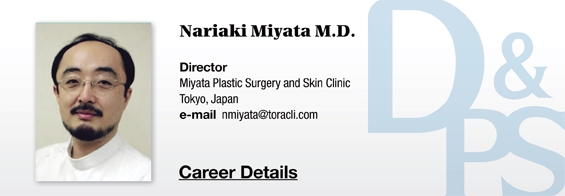
Some doctors get paid to appear on print or TV advertisements and promote new devices that have no scientific evidence. This is not a problem unique to Japan but I think endorsing unproven devices just because you are paid by the manufacturer is putting financial gain before your responsibility as a doctor. This is one of many problems we are facing in the Japanese medical market.
Japanese people generally enjoy high-quality medical service. However, the market for aesthetic medicine is still small and has a long way to go before it reaches the size of the aesthetic market in Korea. Looking at numbers of specialists, there are 2,257 plastic surgeons, 8,686 dermatologists but only 444 aesthetic clinicians (2012 statistics).
At a close look, the Japan Society of Plastic and Reconstructive Surgery has 4,600 members (2,191 specialists), and the Japanese Dermatological Association has 12,000 members (6,129 specialists). The two aesthetic surgical associations of Japan are Japan Society of Aesthetic Plastic Surgery(JSAPS) and Japan Society of Aesthetic Surgery (JSAS), each boasting about 1,000 members. The Japanese Society of Aesthetic Dermatology has about 2,000 members. These are small numbers considering there are at least 300,000 medical doctors in Japan.
Japan has a well-established health care system and most specialists practice medicine under the national health care system. Younger dermatologists are venturing into uninsured aesthetic treatments but few doctors in smaller cities or older doctors are interested in aesthetic treatments. The Japanese health care system has many problems such as low prices but general practitioners with private practice make an average of JPY 25 million solely from health care covered treatments. The widespread unwillingness to go into uninsured aesthetic treatments among Japanese doctors is understandable.
Despite such hurdles, aesthetic medicine has gained more recognition in the last decade. Many Japanese people are becoming more interested in aesthetic procedures and more doctors are starting to specialize in aesthetic medicine. Over 30% of all medical school entrants are women and tend to choose aesthetic medicine as they go through childbirth. Many female doctors are participating in academic seminars and conferences in this field.
[Advertisement] A-One LITE(Facial Diagnosys System) – Manufacturer: BOMTECH(www.bomtech.net)
On one hand, it is encouraging that more doctors are specializing in aesthetic medicine. However, there are also problems. There are very few doctors who are able to provide quality training in academic institutions and university hospitals in this specialty. With insufficient training and education, many doctors enter the practice without necessary skills and are not able to choose the right device for treatments. Many of these doctors make basic mistakes or focus too much on the business side of their practice. Many doctors that make appearance on magazine advertisements do not hold specialist license or have expert knowledge of the treatment they are touting. One often sees beautiful female doctors promoting aesthetic procedures but patients who fall for such a marketing ploy end up becoming very unhappy with the treatment. Some doctors even lie about their credentials and are hired by the manufacturer to promote their products.

Figure 1. Dr. Nariaki Miyata continues to study new devices and treatments and tries to inform other Japanese doctors about exciting new developments in aesthetic medicine.
-To be continued




















